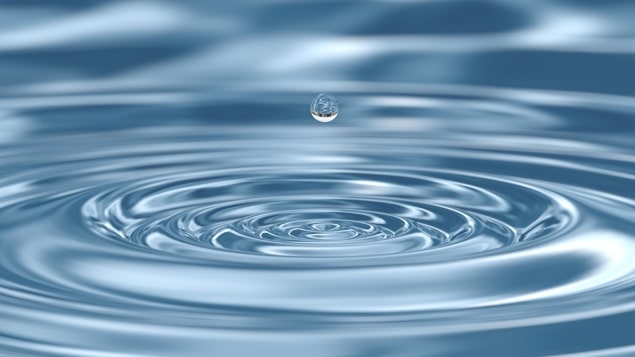Hidden patterns found on the surface of water
19 Aug 2022 Katherine Skipper
Soft and bumpy: work on soft air–water interfaces was pioneered over 10 years ago. (Courtesy: Shutterstock/Grayson)
Scientists in the US have found evidence that the surface of liquid water, even at room temperature, has a structure that looks more and more like ice as the water–air interface is approached. Phillip Geissler and Nathan Odendahl of the University of California, Berkeley, performed computer simulations of the uneven interface between air and water and identified ordered motifs, which they argue share significant commonalities with ice.
From the atmosphere to human lungs, many of the most important processes on the planet happen at the surface of a water droplet, giving this research potential implications across physics, chemistry and biology.
“The things that we’ve worked so many decades to understand about water in its bulk environment just become wrong at interfaces,” said Geissler, who used simulations to study water on a molecular level not accessible in experiments. Spectroscopic measurements of the air–water interface have produced surprising results, suggesting ordered hydrogen bonding at the surface. Geissler and Odendahl were curious about previous simulations, which suggested ice as the reference point for interfacial water’s structure, but they did not think these results were conclusive. As a result, they devised a way to search for these patterns in greater detail.
Searching for structure in disorder
Liquid water is disordered, so the researchers knew that the structures they were looking for would be hard to find, extending over only a few molecules and buried under noise. They had the idea that previous researchers were missing details because they had treated the interface as a flat plane, when it is actually soft and bumpy. Work on soft air–water interfaces was pioneered over 10 years ago and revealed layers parallel to the surface, but Geissler and Odendahl were the first to use this to look for a link with ice. Ordered molecules: the diagram on the left shows the sublayers at the basal face of ice. L0 is the surface. The diagram on the right shows the orientations at the air–water and air–ice interfaces (Courtesy: N Odendahl and P Geissler Journal of the American Chemical Society 144 25 11178)
Ordered molecules: the diagram on the left shows the sublayers at the basal face of ice. L0 is the surface. The diagram on the right shows the orientations at the air–water and air–ice interfaces (Courtesy: N Odendahl and P Geissler Journal of the American Chemical Society 144 25 11178)
 Ordered molecules: the diagram on the left shows the sublayers at the basal face of ice. L0 is the surface. The diagram on the right shows the orientations at the air–water and air–ice interfaces (Courtesy: N Odendahl and P Geissler Journal of the American Chemical Society 144 25 11178)
Ordered molecules: the diagram on the left shows the sublayers at the basal face of ice. L0 is the surface. The diagram on the right shows the orientations at the air–water and air–ice interfaces (Courtesy: N Odendahl and P Geissler Journal of the American Chemical Society 144 25 11178)Geissler said he was surprised when Odendahl showed him the first results superimposing the ice and water–air interfaces. They argue that, with the extra detail of the instantaneous interface, the layers at the surface of water can be split into sublayers (see above figure). Parallel sublayers are a feature of the basal face of ice, and they present what the duo is convinced is a striking resemblance between these layers in the ice and water–air interfaces.
Using these sublayers as a reference point, Geissler and Odendahl compared the orientations of the molecules, knowing that this is well defined for tetrahedral water molecules in ice. When the researchers mapped the favoured direction of the oxygen–hydrogen bonds near the water’s surface, they observed ordering, which they again argued, seems to correspond to a face of ice. These patterns hold over a few molecular diameters, which is larger than the transient tetrahedral structures expected in bulk water.
Broken symmetry forces water to organize
Arguing for their conclusions, Odendahl said “Having that flexible interface really gave us the confidence to say, it’s not just a couple of chance metrics. If you look at the density, if you look at the orientation, if you look the multiple layers just everything that we looked at, there seemed to be a match.”READ MORE

However, interpreting research on the statistical mechanics of liquids is always contentious. The continued debate over the water–air interface will come down to the fundamental question of how ice is defined, and whether a structure that extends over only a few molecules can be said to have crystal-like properties. Reflecting on their results, Geissler said “We now have this structural reference point for thinking about these structural motifs, and I think that that will, in the end prove to be a very useful conceptual tool.”
The research is described in the Journal of the American Chemical Society.Phillip Geissler died unexpectedly in July 2022 while hiking in Utah, he was 48.

Katherine Skipper is a PhD student contributor to Physics World. Katherine is based at the University of Bristol, where she studies experimental active matter. Find out more about our student contributor networks
from physicsworld.com 28/8/2022

Δεν υπάρχουν σχόλια:
Δημοσίευση σχολίου